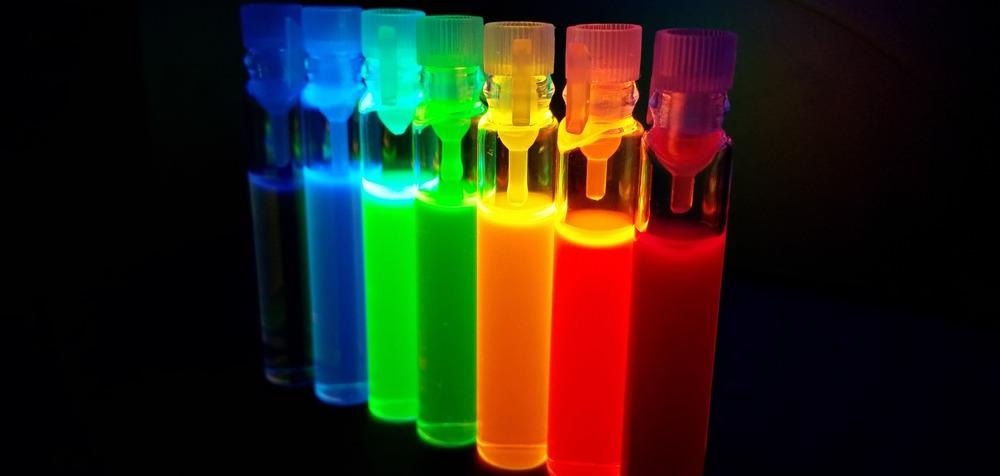An international team of researchers from Skoltech, Russia, and Ludwig Maximilians-Universität (LMU), Germany, has gained a new understanding of halide perovskite nanocrystals. Its recent study reveals intricate connections between the composition, light-induced lattice dynamics, and stability of the promising optoelectronic material.

Image Credit: Leo Matyushkin/Shutterstock.com
Perovskite Nanocrystals
In research recently published in Nature Communications, scientists inspected perovskite nanocrystals (PNCs), uncovering new information about their unique properties.
The research was carried out at LMU and the Skoltech Center for Energy Science and Technology (CEST) in Russia. Skoltech is a private international university established in 2011, in collaboration with the Massachusetts Institute of Technology (MIT).
PNCs have an ABX3 composition, where A = cesium, methylammonium (MA), or formamidinium (FA); B = lead or tin; and X = chloride, bromide, or iodide. They are a type of semiconductor nanocrystal and operate as quantum dots.
Because of their unusual band structure, PNCs are almost totally tolerant to defects. This also enables them to emit brightly without surface passivation. Other quantum dots such as CdSe have to be passivated to emit brightly.
PNCs continue to emit brightly when the nanocrystal’s size results in only weak quantum confinement. This means that nanocrystals exhibiting narrow emission linewidths can be produced, regardless of polydispersity.
New Look at PNCs
PNCs’ structures evolve because of lattice dynamics. This is the process of atoms structuring following excitation from a laser pulse whose duration is shorter than the period of vibrational modes in the light source.
Using femtosecond pump-probe spectroscopy, researchers observed these lattice dynamics in real-time. The spectroscopy method gathered data on the coherent lattice vibrational dynamics for hybrid halide PNCs. Researchers used atomistic modeling to explain this data.
Findings from the Recent Research
Using this inspection method, researchers uncovered new information about PNCs. Comparing vibrational modes in iodine-based PNCs to bromine-based PNCs, they found that energy transfer in the iodine-based nanocrystals was much more pronounced.
This was attributed to changes in the interaction between the organic moiety in organic-inorganic halide PNCs and their inorganic framework.
These results may lead to a means toward rational control of PNCs’ fundamental properties. These properties include energy transfer after optical excitation and charge-carrier relaxation, and can be controlled with compositional changes.
Applications for PNCs
PNCs are a class of semiconductor nanocrystals that have been applied in a variety of optoelectronics settings. They are used in high-performance lasers and LEDs, and have even been investigated for their potential as photocatalytic materials.
Photocatalysts can be used to convert water into hydrogen gas through photocatalytic water splitting. They can also be used for water decontamination by removing and destroying organic contaminants in groundwater through adsorption.
As semiconductor nanocrystals, PNCs display characteristics that make them unique to traditional quantum dots. Compared to bulk materials, PNCs exhibit far greater levels of photoluminescence quantum yield.
In addition to these desirable characteristics, quantum-confinement at the nanoscale is also possible in PNCs. This could be another technique for tuning the optical properties of nanocrystals.
Nanocrystals made from metal halide perovskites also work better when defects occur, compared to other semiconducting materials. This is due to the unique electronic properties of metal halide perovskites.
References and Further Reading
Debnath, Tushar et al. (2021) Coherent Vibrational Dynamics Reveals Lattice Anharmonicity in Organic–Inorganic Halide Perovskite Nanocrystals. Nature Communications. https://doi.org/10.1038/s41467-021-22934-2.
Kobosko, Steven M., Jeffrey T. DuBose and Prashant V. Kamat (2020) Perovskite Photocatalysis. Methyl Viologen Induces Unusually Long-Lived Charge Carrier Separation in CsPbBr3 Nanocrystals. ACS Energy Letters. [Online] https://doi.org/10.1021/acsenergylett.9b02573.
Disclaimer: The views expressed here are those of the author expressed in their private capacity and do not necessarily represent the views of AZoM.com Limited T/A AZoNetwork the owner and operator of this website. This disclaimer forms part of the Terms and conditions of use of this website.